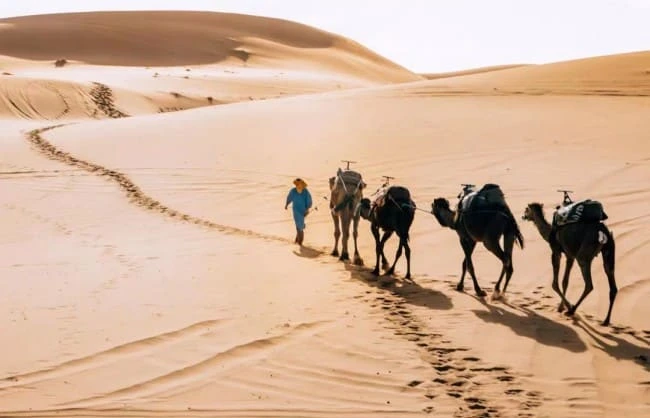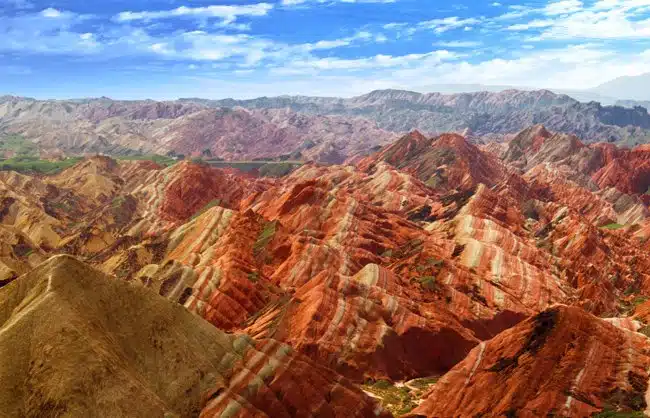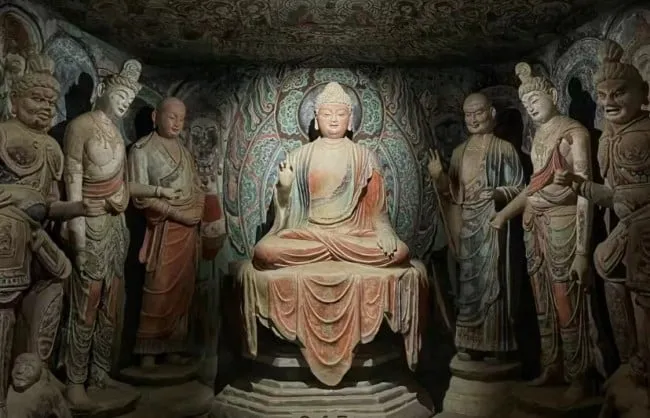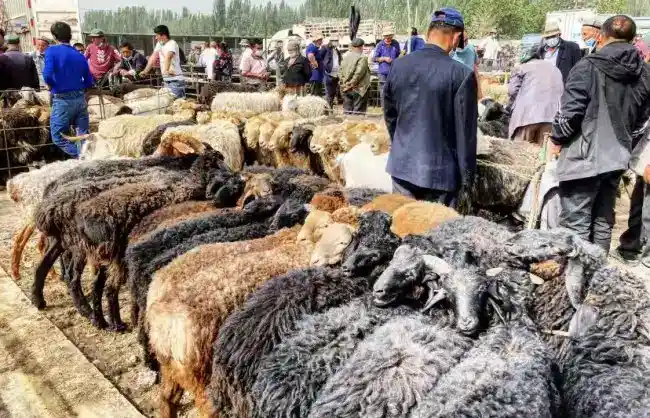Once an epic route for commercial trade and cultural exchange between China, Central Asia, and distant realms of the West over thousands of years ago, the ancient Silk Road bears witness to the resplendent history, and fusion and collision of different civilizations. Today, it serves more like a living museum, offering a tangible connection to millennia-old heritages, relics, ruins, exotic cultures, etc.
Within China, the Silk Road stretches thousands of kilometers through different historic cities, vast deserts, and diverse landscapes and heritages, making it a daunting task to plan a Silk Road trip. And this ultimate Silk Road travel guide is here to help.
You can travel the Silk Road in China either in full or in parts, depending on your interests and time. If you are wondering how to plan your China Silk Road tour? Where to Go? What activities to experience? How long to plan? At what time of year to visit? And which transport forms to choose? This guide will give you all the answers to how to plan a Silk Road trip of a lifetime.

Top Silk Road Cities in China & Their Highlights
Xian
The east starting point of the ancient Silk Road, and one of China’s four great ancient capitals. It is home to the world-renowned Terracotta Army and abundant cultural and historical heritages. The ancient city wall of Xi’an is the largest and best-preserved in China. The Giant Wild Goose Pagoda offers a glimpse into the dissemination of Buddhism during the Tang Dynasty.
Beyond these, this ancient capital will also entertain you with its iconic Drum Tower and Bell Tower, Great Mosque, Mt. Huashan, and many museums of different themes. >>Learn more highlights of Xian

Tianshui
Known for its Maiji Mountain Grottoes, which is one of its four major grotto art sites. The 221 grottoes house countless Buddhist treasures from over ten dynasties, including 3938 statues, and 979.54 square meters of murals.
Lanzhou
A gateway to far northwest China, Lanzhou is a city with the Yellow River flowing through. Its Yellow River Scenic Area boasts the longest urban riverside promenade in China, stretching over a hundred kilometers. This riverside road is dotted by many notable attractions, including Waterwheel Park, Zhongshan Bridge, etc.
Wuwei
Wuwei is an important city on the Hexi Corridor. It is famous for the “Flying Horse of Gansu” at the Leitai Han Tombs, which has become a symbol of Chinese tourism. This bronze galloping horse epitomizes the peak of sculptural art from the Han Dynasty.
Zhangye
Zhangye stands out for its Danxia National Geological Park, featuring colorful rainbow-like mountains. Furthermore, the wooden reclining Buddha statue in Zhangye Grand Buddha Temple is also impressive.

Jiayuguan
Once a significant Silk Road gateway, Jiayuguan Pass is the western end of the Ming Great Wall. The overhanging Great Wall on the north of the pass was constructed along a steep mountain slope, making it an awe-inspiring architectural marvel.
In Jiayuguan, you’ll also get a chance to look into ancient paintings and artistic culture at Wei and Jin Dynasty Tombs, and Black Mountain Rock Carvings.
Dunhuang
Dunhuang attracts world-wide tourists for its Mogao Grottoes, a UNESCO World Heritage site for its grand scale, rich mural content, and artistic diversity. Also, it is where you can marvel at the desert scenery formed by Mingsha Mountain and Crescent Spring. >>Learn more about Dunhuang Travel Guide

Urumqi
Urumqi is the capital and gateway of Xinjiang. It is where you can meet the Heavenly Lake on Tianshan Mountain, and the ethnic customs at International Grand Bazaar.
Yining
Nestled in western Xinjiang, Yining is marked by the Horgos Port, the Ili River Scenic Belt, and fields of lavender.
Turpan
The World Heritage Sites – Gaochang Ruins and Jiaohe Ruins and Bezklik Thousand Buddhas Caves are testaments to its prosperity of past civilizations. Additionally, Turpan is famous for the Flaming Mountains, Grape Valley, Emin Minaret, and Karez Wells.
Kucha
Kucha is the historical site of the ancient Qiuci Kingdom. The first Buddhist grotto art site – Kizil Thousand Buddha Caves and the Subash Ruins make it a cultural heavyweight on the ancient Silk Road.
Kashgar
Here you can delve into the authentic Uygur cluture, architecture, and workshops in the over 2000-year-old Kashgar Old Town. Also, it is home to many historical landmarks, such as Id Kah Mosque, Abakh Hoja Tomb, and Kashgar Bazaar. You can also head to the Karakul Lake to admire the natural beauty of Xinjiang. >>Learn more about Kashgar Travel Guide
Related Reading:

What to Do and Experience?
To travel the Silk Road will reward you with a captivating journey that seamlessly blends historical and natural marvels as well as diverse cultural experiences. Below are some activities and experiences you can anticipate during a Silk Route odyssey.
Historical Discovery
This ancient trading route is steeped in millennia-old cities and time-honored relics and structures. You will travel through Xi’an, Dunhuang, Jiayuguan, Kashgar, etc. to discover countless historical sites. Some of the top historical and cultural landmarks along Silk Road include Giant Wild Goose Pagoda, Xi’an City Wall, Kashgar Old Town, etc.
Many World Heritage Sites
Along this epic route are a wealth of World Heritage Sites. And some notable examples include Mogao Grottoes, Jiayuguan Great Wall, Gaochang Ancient City, Jiaohe Ancient City, etc. They are inscribed by UNESCO thanks to historical significance, architectural marvels, artistic beauty, or cultural importance.
Natural Wonders
Spanning thousands of kilometers, the Silk Route is also famous for its diverse geological landscapes. You can expect natural wonders such as deserts, snow-capped mountains, canyons, plateau lakes, grasslands, and more along this historic route. Some of the most breathtaking natural attractions include Zhangye Danxia Park, Altai Mountains, Echo Sand Mountain, Heavenly Lake, Kanas Lake, etc.
Ethnic Culture and Religions
Traveling the Silk Road in China will introduce you to diverse ethnic groups, including Uyghurs, Kazakhs, Mongolians, Hui, and more. To immersively experience their culture and traditions, you can enjoy time in local markets and bazaars, join in their folk dances and music, learn to eat like a local, and calm your spirit in a local monastery.
Silk Road-Themed Shows
To glimpse into the mysteries and charms of the legendary Silk Road, you can add some Silk Road shows and performances to your trip. Some of the most classic shows include Silk Road, Flower Rain, Dunhuang Celebration, and Encore Dunhuang.
Diverse Outdoor Adventures
Another charming facet of Silk Road travel is the diverse outdoor adventures it offers. More than just treks and off-road driving across the Gobi Desert, you can also indulge in desert camping, hike amidst breathtaking scenery, engage in horseback or camel riding, challenge rock climbing, and partake in wildlife observation, etc.
Best Time to Travel Silk Road
The climate varies along the Silk Road since it spans multiple climate zones and geographical areas. While, generally, May to October is considered the best time to visit most Silk Road destinations in China.
During this period, the temperatures are relatively mild, allowing visitors to avoid the more frequent sandstorms in early spring, particularly if you are planning visit deserts and Gobi areas.
General Weather and Climate in Different Regions
Eastern Starting Point: Xian
Xian enjoys a temperate monsoon climate, featuring hot and humid summers (with abundant rainfall), cold and dry winters. Usually experiences rapid temperature increases and decreases in spring and autumn.
Northwest Inland: Ningxia, Gansu, North Xinjiang
These regions have a temperate continental climate, featuring large large diurnal and annual temperature differences, scarce rainfall, and strong solar radiation. These regions have distinct seasons, with hot summers, cold winters, and drastic temperature changes in springs and autumns.
Southern Xinjiang
Areas around Taklamakan Desert see a tropical desert climate, with rare rainfall, and extremely large diurnal temperature differences.
Recommended Destinations in Different Seasons
- Spring (March – May): Xian, Luoyang, Dunhuang, Turpan, Urumqi
- Summer (June – August): Zhangye, Jiayuguan, Kashgar, Ili, Qinghai Lake
- Autumn (September – November): Yinchuan, Ejina Banner, Urumqi, Dunhuang, Xian, Kanas Scenic Area
- Winter: (December – February): The low-season for most areas. Recommend to visit hot attractions like Mogao Grottoes, Terracotta Army when it is less crowded. Qinghai Lake will see flocks of migratory birds in winter.
Related Reading: Best Time to Visit China
How Long Did It Take to Travel the Silk Road
The exact duration may vary according to your preferences, budgets, and schedule. Because you can either enjoy an in-depth Silk Road exploration to most destinations or a quick tour to parts of its highlights. Below are some itinerary ideas for different durations for your reference.
4-5 Days:
If with only 4-5 days available, it is advisable to focus on some iconic attractions in some core cities, like Xian, Dunhuang, Jiayuguan, etc. For example, you can look into the cities along the Hexi Corridor, or arrange Xian and Dunhuang in one Silk Road trip.
Recommended 4-5 Days Silk Road Tours:
- 5 Days Highlights Silk Road Tour: Xi’an & Dunhuang
- 5 Days Hexi Corridor Silk Road Tour of Lanzhou-Wuwei-Zhangye
- 4 Days Xian-Lanzhou-Xiahe Tour by Train
6-7 Days:
This time frame is still limited for the epic Silk Road, and we recommend a quick tour in some iconic cities. For example:
- Spend 2 days in Xian for the Terracotta Army and iconic landmarks;
- 2 days in Dunhuang Mogao Caves and desert landscapes and adventures;
- 1 day in Zhangye to admire the Rainbow Mountain and Giant Buddha Temple;
- 1 day in Jiayuguan for the massive walls, watchtowers, gates, fortresses, and rugged desert landscapes.
Also, you can spend your entire time to explore Dunhuang and Xinjiang highlights. Or, enjoy a classic Xinjiang tour in 5-7 days.
Recommended 6-7 Days Silk Road Tours:
- 7 Days Silk Road Small Group Tour of Xian-Zhangye-Jiayuguan-Dunhuang
- 7 Days Silk Road Tour from Xi’an to Dunhuang by High-speed Train
- 6 Days Ningxia Ultimate Vacation: Desert Camping & Winery
- 7 Days Silk Road Dunhuang-Turpan-Urumqi-Kashgar Tour
7-14 Days:
This duration allows you a more comprehensive experience with historical and cultural highlights, as well as natural marvels.
- 2-3 days in Xian for a deeper exploration of its iconic landmarks and surrounding areas, like Mt. Huashan;
- 1 day in Lanzhou for leisure stroll along the Yellow River;
- 2 days in Dunhuang for Mogao Grottoes, Echoing Sand Mountain & Cresent Lake;
- 1 day in Jiayuguan for Jiayuguan Pass and the surrounding ancient Great Wall and desert landscape;
- 2 days in Zhangye for the Rainbow Mountain, Giant Buddha Temple, and Pingshan Lake Grand Canyon;
- 3-5 days in Xinjiang for international bazaar in Urumqi, and Kashgar Ancient Town and Turpan in South Xinjiang, or Kanas Lake and Altay Mountains in North Xinjiang.
Recommended 7-14 Days China Silk Road Tours:
- 8 Days Silk Road Adventure Tour from Xining to Dunhuang
- 10 Days Ancient China Silk Road Tour from Xian to Kashgar
- 12 Days China Silk Road Tour from Beijing to Kashgar
- 14 Days Silk Road and Northern Xinjiang Tour
More Than 14 Days:
With ample time, you can enjoy an in-depth exploration of the diverse cultures, historical treasures, and natural wonders during your Silk Road trips.
Besides the itinerary arrangement in Xian, Jiayuguan, Lanzhou and Dunhuang we mentioned above, you can add Leitai Han Tombe in Wuwei, Weijin Tombs in Jiayuguan and Maijishan Grottoes in Tianshui in your trip as well.
Considering the vast scale and diversity of Xinjiang, we recommend to spend 7 or more days to cover all its best highlights.
Recommended 14+ Days China Silk Road Trips:
- 15 Days Silk Road Tour: Xian-Gansu-Qinghai-Xinjiang-Yinchuan
- 15 Days In-depth Silk Road Tour from Xian to Xinjiang
- 16 Days Silk Route Adventure & Modern China Tour
- 17 Days Itinerary of Silk Road Exploration with Zhangjiajie
Silk Road Transportation: How to Get to Major Destinations
By Air
Flights are convenient choice for long-distance interprovincial travels. Most cities along the Silk Road can be accessed by flight from major domestic cities. Some capital cities also offer international flights for foreign tourists to reach conveniently. Below are brief introductions of some major airports:
- Xi’an Xianyang International Airport: An aviation hub in northwest China, offers direct flights to most domestic cities like Beijing, Shanghai, Chengdu, Guilin, Guangzhou, Lanzhou, Urumqi, etc. Direct international flights are also available for reaching Japan, the USA, Australia, Singapore, etc.
- Lanzhou Zhongchuan International Airport: The gateway airport for Gansu Province, offers direct flights to most domestic cities.
- Dunhuang Mogao Airport: A relatively small airport, offering flights from major domestic cities like Beijing, Shanghai, Xian, and Lanzhou.
- Jiayuguan Airport: Offers fewer domestic flights, allowing direct flights from Beijing, Xian, Lanzhou, Dunhuang, Chengdu, etc.
- Urumqi Diwopu International Airport: The aviation hub in Xinjiang, offers direct flights to most domestic cities and an extensive network of international routes.
- Kashgar Airport: The aviation hub in southern Xinjiang, offers direct flights to most Xinjiang destinations and major domestic cities like Beijing, Shanghai, and Xian.
By Train
High-speed train is the top choice for medium to short-distant travel, with scenic appreciation a bonus. The Baoji-Lanzhou, Zhengzhou-Xi’an, Lanzhou-Xinjiang, and Yinchuan-Lanzhou high-speed railways highly contribute to the convenient and fast transfer between most destinations along China Silk Road.
Recommended Silk Road Tours by Train:
- 4 Days Xian-Lanzhou-Xiahe Tour by Train
- 7 Days Silk Road Tour from Xi’an to Dunhuang by High-speed Train
- 12 Days China Silk Road Tour from Xian to Urumqi by High Speed Train
Accommodation Tips for Silk Road Travel
Since the Silk Road winds its way through various bustling metropolises and serene towns, the accommodation options along the way vary from place to place. International four-star and five-star hotels are abundant in major cities like Xian, Lanzhou, and Urumqi. Meanwhile, in historical cities or ancient towns like Dunhuang and Kashgar, guesthouses and boutique accommodations are more popular.
Accommodation tips for different cities:
- Xian: Recommended to select hotels near Bell Tower, South Gate, or Xiaozhai. These are the city center areas, with convenient transportation options and within walking distance to the Ancient City Wall, Bell Tower, and Muslim Quarter.
- Dunhuang: Hotels near Echo-sand Mountain allow you to conveniently enjoy desert sunrise and sunset, and thrilling activities. Dunhuang city center area is also a good choice for easy access to the local night market.
- Turpan: Recommend staying overnight in Gaochang District or around the Grape Valley Scenic Area.
- Kashgar: Guesthouses in Kashgar Old City are the top choices for you to immerse into the local architectural and ethnic culture.
- Urumqi: Tianshan District is the city center, near the International Grand Bazaar.
- Zhangye: Ganzhou District in the city center offers more accommodation choices. Hotels near the Rainbow Danxia Scenic Area allow you to conveniently appreciate the sunrise and sunset over the Rainbow Mountains.
What to Eat on a China Silk Road Trip
Influenced by flavors of different regions from Central Asia to Europe, foods in cities along the Silk Road reflect a blend of different ethnic groups and diverse cultures.
Islam’s introduction via the Silk Road has influenced many region’s culinary landscapes. For example, in cities like Urumqi, Kashgar, and Turpan where Islam plays a central role, halal food plays an important role in the local cuisine scene. And the food in these cities is dominated by ingredients like beef, lamb, and various spices (such as cumin and chili).
Due to the eating habits in northern China, noodles are especially prevalent in many cities along the Silk Road. For example, in Xian’s streets, you can easily find various noodle dishes like “oil-splashed noodles”, “biangbiang noodles”, and “saozi noodles”. In Zhangye, “twisted fish noodles” are popular, and Lanzhou beef noodles are even renowned around China.
Generally, street food culture is vibrant in most cities along the Silk Road, with each city having its own representative food streets. The Muslim Quarter in Xian, Kashgar Old City, Shazhou Night Market in Dunhuang, and the pedestrian street in Urumqi’s Grand Bazaar are some of the famous ones.
Read more on Top 10 Silk Road Foods You Must Try
Packing Tips for Traveling Silk Road
- Essential Documents: Valid visa and passport, travel insurance, flight and hotel reservations, etc.
- Electronics: smartphone (download necessary maps, translation apps, and payment apps), power bank, portable Wi-Fi or SIM card, etc.
- Currency: Carry a certain amount of Chinese Yuan in cash just in case.
- Medicine: Bring common medicine for colds, diarrhea, travel sickness, etc., and necessary prescription medications from your doctor, just in case.
- Clothing: Layer your clothing due to temperature variations; a thin jacket is still advisable in summer considering the cooler temperatures in the morning and evening, and air-conditioned indoors.
- Sun Protection: Due to the strong UV radiation in northwest China, high-SPF sunscreen, hats, and sunglasses are necessary.
- Dryness Protection: Lip balm, moisturizer, and other skincare products, portable water bottle.
- Respect Local Cultural: Dress long pants and long-sleeved tops when visit religious sites or certain regions with strict cultural customs.
Discover more travel tips for your China Silk Road trip.
Customize Your Silk Road Tours with Us
Having operated China Silk Road tours for over 15 years, we know this ancient trading route like the back of our hand. Whether you want personalized Silk Road tours for seniors, solos, or kids, our professional team can craft your ideal itinerary based on your unique energy, preferences, travel styles, and time frame. If you have any travel ideas or inquiries, please feel free to contact us.









